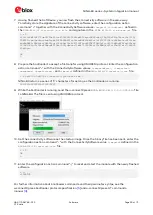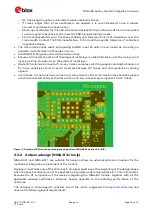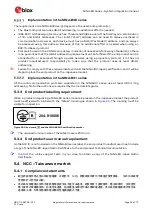
NINA-B3 series - System integration manual
UBX-17056748 - R13
Design-in
Page 41 of 72
C1-Public
NINA-B3 modules have been tested with a 3 x 3 cm PCB trace antenna, so it is recommended to keep
an antenna design close to these measurements. You can still use a smaller or larger antenna as long
as it is tuned to resonate at 13.56 MHz. To comply with European regulatory demands, the NFC
antenna must be placed in such a way that the space between the NINA-B3 module and the remote
NFC transmitter is always within 3 meters during transmission.
Figure 15: NFC antenna design
𝐶
𝑡𝑢𝑛𝑒
′
=
1
(2𝜋 × 13.56 𝑀𝐻𝑧)
2
𝐿
𝑎𝑛𝑡
𝑤𝑒𝑟𝑒 𝐶
𝑡𝑢𝑛𝑒
′
=
1
2
× (𝐶
𝑝
+ 𝐶
𝑖𝑛𝑡
+ 𝐶
𝑡𝑢𝑛𝑒
)
𝐶
𝑡𝑢𝑛𝑒
=
2
(2𝜋 × 13.56 𝑀𝐻𝑧)
2
𝐿
𝑎𝑛𝑡
− 𝐶
𝑝
− 𝐶
𝑖𝑛𝑡
3.6.1
Battery protection
If the antenna is exposed to a strong NFC field, current may flow in the opposite direction on the
supply because of parasitic diodes and ESD structures.
If the battery used does not tolerate a return current, a series diode must be placed between the
battery and the device in order to protect the battery.
3.7
General High Speed layout guidelines
These general design guidelines are considered as best practices and are valid for any bus present in
NINA-B3 series modules; the designer should prioritize the layout of higher speed buses. Low
frequency signals are generally not critical for layout.
⚠
One exception is represented by High Impedance traces (such as signals driven by weak pull
resistors) that may be affected by crosstalk. For those traces, a supplementary isolation of 4w
from other buses is recommended.
3.7.1
General considerations for schematic design and PCB floor-planning
•
Verify which signal bus requires termination and add series resistor terminations to the
schematics.
•
Carefully consider the placement of the module with respect to antenna position and host
processor.
•
Verify with PCB manufacturer allowable stack-ups and controlled impedance dimensioning.
•
Verify that the power supply design and power sequence are compliant with NINA-B3 series






























